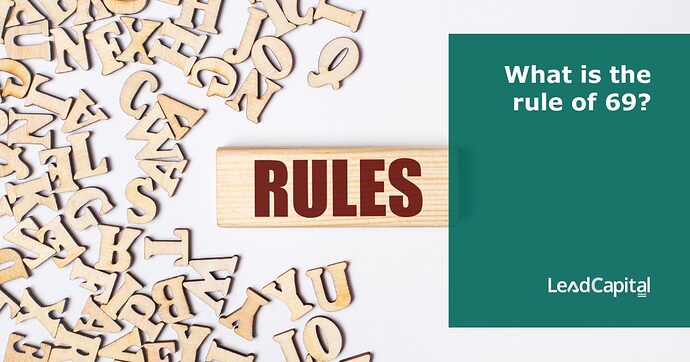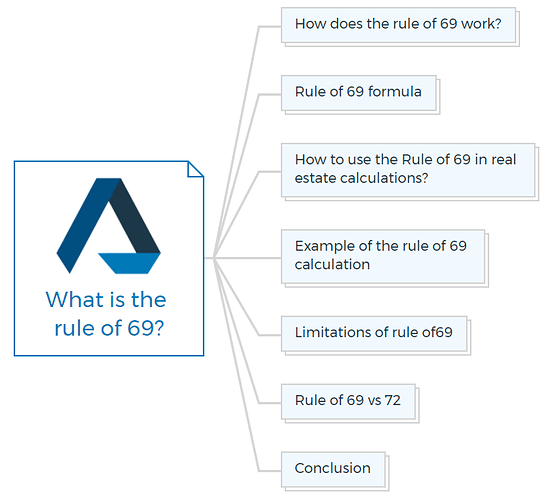Rule of 69: The secret to long-term wealth building
Learning the fundamentals of real estate finance is a must if you want to succeed as an investor. The Rule of 69 is a principle worth understanding. This method is a simple and practical tool for calculating an approximate time over which an investment will double in value.
What is the rule of 69?
The rule of 69 is a quick way that helps to estimate how long it will take for an investment to double in value at a specific rate of return. Financial planners, analysts, and real estate investors frequently employ this method, which depends on the mathematical concepts of exponential growth.
An investment’s time to double in value is about equal to 69 divided by its annual rate of return, according to the Rule of 69.
For example, it would take about 6.9 years for a $70,000 investment to double in value if the annual rate of return was 10% (69 divided by 10 equals 6.9).
Learn more - Principal and interest vs Interest only loans?
You are missing out if you haven’t yet subscribed to our YouTube channel.
How does the rule of 69 work?
The general rule of 69 depends on the concept of compound interest. Your investment grows as you earn interest on the principal and previous interest.
Your investment’s growth rate will be proportional to the rate of return it receives. A higher rate of return means your money will multiply more quickly.
Rule of 69 formula
Number of Years to Double = 69 / Annual Rate of Return
How to use the Rule of 69 in real estate calculations?
The Rule of 69 helps real estate investors anticipate how long their properties will double in value.
Real estate investments often yield rental income and appreciation. Rental revenue comes from renting the property, while appreciation is the property’s value rising over time.
The annual rate of return of your investment is needed to employ the Rule of 69 in real estate calculations.
Divide the entire return by the initial investment and multiply by 100.
How To Finance Your Property Development Project?
And Other Books On Real Estate Development Finance
Includes 5 x detailed eBooks
✓ Property Development Finance: Easily Finance Your Project? (26 Pages)
✓ 10 Big (Financial) Property Investing Mistakes Made By Investors (58 Pages)
✓ 10 Finance Options For Your Next Property Development Project (29 Pages)
✓ What Is Equity Finance And How Does It Work? (42 Pages)
✓ Property Investment Finance - Ultimate Guide
Example of the rule of 69 calculation
If you invest $100,000 and get $10,000 in rental income and $20,000 in appreciation, your total return is $30,000.
The annual rate of return
Total Return/Initial Investment x 100 = Annual Rate of Return
Annual Return = $30,000/$100,000 x 100
= 30% Annual Return
You can estimate how long it will take for your property to double in value using the Rule of 69:
Numbers of years to double = 69/Annual Rate of Return
Number of years to double = 69/30
Number of years to double = 2.3 years
Based on the 30% annual rate of return, your property would double in value in a period of 2.3 years.
Learn more - How to calculate ROI in real estate? - The Ultimate Guide
Limitations of rule of 69
The Rule of 69 is only an approximation. It assumes a constant rate of return, which is not necessarily the case in real estate investing. Inflation and taxes can affect the return on investment.
The Rule of 69 should be used as a tool to predict returns rather than as the only foundation for investment decisions because real estate investing is a complex process involving several aspects.
Rule of 69 vs 72
The Rule of 69 and 72 are simple strategies for determining the number of years an investment will double in value. The calculation factor distinguishes the rules.
The Rule of 69 uses the number 69 as the factor, while the Rule of 72 uses the number 72.
The formula for the Rule of 72 is:
Number of Years to Double = 72 / Annual Rate of Return
The Rule of 72 is easier to apply and more well-known. The Rule of 69 is a better estimate of the number of years it takes an investment to double in value.
As return rates rise, the two rules diverge more. At a 10% rate of return, the Rule of 69 estimates that an investment will double in 6.9 years, while the Rule of 72 estimates 7.2 years.
The Rule of 69 forecasts that an investment will double in value in 3.45 years at a 20% rate of return, while the Rule of 72 estimates a doubling in 3.6 years.
Both the Rule of 69 and the Rule of 72 can estimate an investment’s expected growth rate. These principles are approximations and should be utilised with additional analysis and research when making investing decisions.
Conclusion
In conclusion, the Rule of 69 is a useful tool for estimating the time it takes for an investment to double in value. It is based on the concept of compound interest and can be applied to real estate investments as well. However, it is important to note that the Rule of 69 is only an approximation and assumes a constant rate of return, which may not be the case in reality.
Other factors such as inflation and taxes can also affect investment returns. The Rule of 69 is just one of many tools that investors can use to evaluate investment opportunities.
Property Finance Made Easy
We specialise in Development funding | Commercial finance | Construction loans | Portfolio refinancing & Property investment loans in Australia.
Click Here to strategise with Amber





